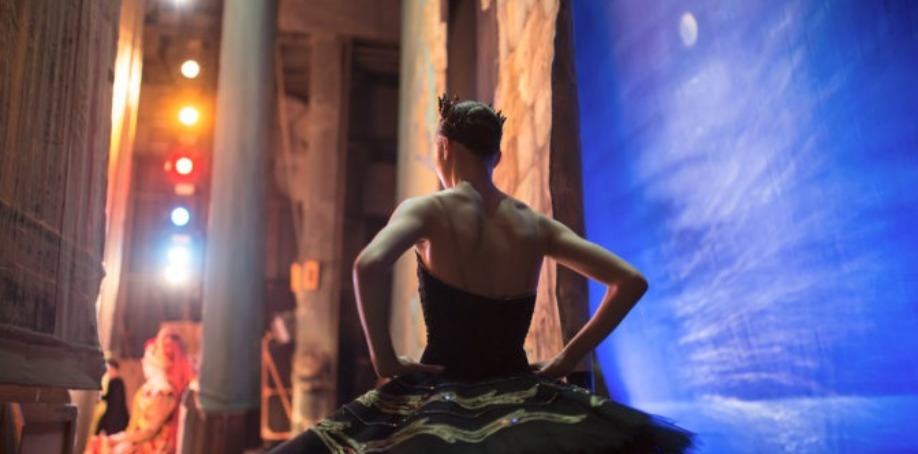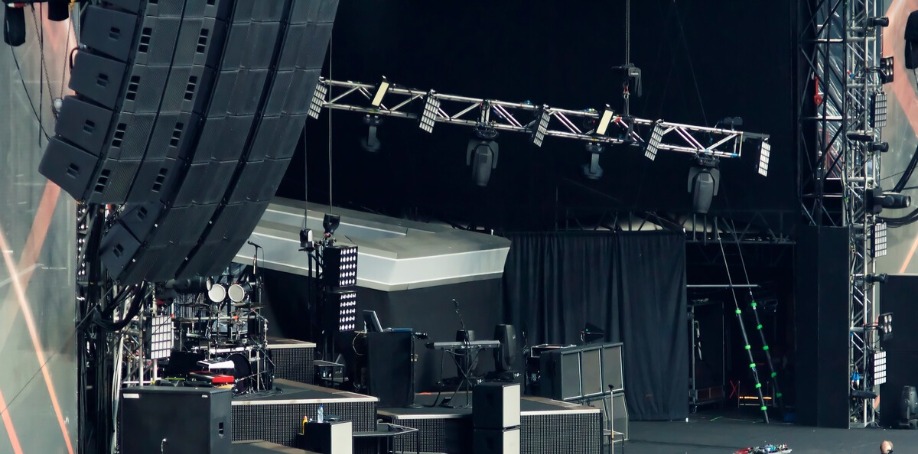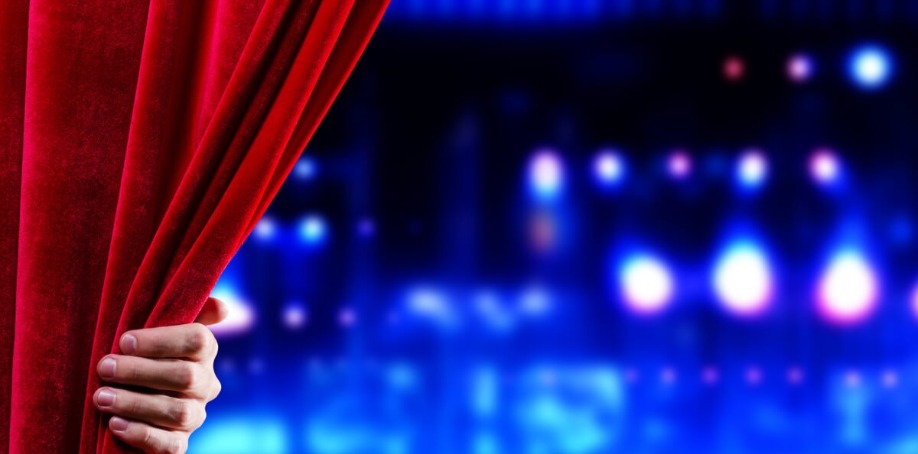
The curtain goes up, the lights go down, and the audience settles in to watch the play. They may expect to see exceptional acting. But if they're sitting in a high-tech theater, they may get so much more.
New technology is changing the way stories are told on the stage. Video over IP, audio over IP, and projection mapping open up horizons for writers, stage directors and other theater professionals — and the audience.
Onstage Revolution
Some of the technology we're discussing in this article isn't new. But recent advancements have made them more accessible for stages large and small.
Ed Cooper, director of Blue-i Theater Technology, says recent advancements push creativity. "Technology advancements with media servers and projection have allowed a more accessible platform for designers and production teams to incorporate video into productions as a new medium, rather than using video for the sake of video," he says.
Early stage productions might use moving pictures as a backdrop. But newer models make the images part of the story. And innovations in sound mean audiences can hear things they've never experienced before.
Some stage owners build with the technology in mind, so they can host these amazing experiences. "We wanted to have as few restrictions on creativity as possible, so that designers and composers can come to the Linbury and let their imaginations run free," says Tom Thompson, technical manager of the Linbury Theatre.
Others find ways to retrofit their existing stages, so they can show off the new technology. But the key is to let the new tools add to, rather than detract from, what's happening on the stage.
Technology to Augment (Not Replace)
With new theatre technology available, it's tempting to use it everywhere. Professionals work hard to ensure the tools support, rather than take over, the story.
"Be prepared to have your creative soul crushed, both by the director and yourself, when you realize that the audience is watching your design and not listening to the play. Less is more, more often than not, in theatrical projection design. Be prepared to wield your own red pen," says director of photography Stephan Mazurek. When used properly, the new tools help the story come to life. But the audience may not even know what's interesting about the show they're watching.
"I'm not interested in the audience thinking, 'Oh gosh, he's terribly clever.' I'm interested in them thinking, 'Wow, the total experience we've had this evening of everything has been wonderful,'” says video designer Finn Ross.

How Can Tech Be Put to Good Use?
Theater pros around the world are walking the fine line between using new technology and not overwhelming the stories they want to tell. They're finding that tech can make their jobs easier.
Enticing people to attend live shows is challenging, says Andrew Flatt, senior vice president of marketing at Disney Theatrical Productions. Showcasing what happens within a show (by sharing live video, for example) has helped convert lurkers into ticket holders. Flashier shows look and sound better on video shares. In theory, adding a pop of tech could help those promotions work better. The fancier the show seems, the more likely tickets could sell.
Shane Jewell, executive director for the Orlando Ballet, predicted the end of painted sets in a piece he wrote for the Clyde Fitch Report in 2015. He wondered how viewers would feel if they could soar through Neverland with Tinkerbell in a ballet performance of Peter Pan. Rather than trying to believe that a flashlight was a nymph, they could see that creature flying in front of them. It would change the ballet, he thought.
Projection mapping and exceptional sound makes that possible. Someone seeing a show like this wouldn't hesitate recommending it to someone else.
New theater technology can also make the impossible seem possible. Matt Trueman wrote a review of the play, “The Great Wave.” He suggests that the stage setup, sound and projection mapping helped tell the tale that spanned two distant locations, something a conventional stage might not do so as effectively.
Every stage team will use these tools differently. But when they are implemented properly, the results can be fantastic.
Case Study: Paul Aster's “City of Glass”
This novel was long considered impossible to stage, as it involves shifting realities, inner dialogue and fantastical sequences. An innovative use of projection mapping brought the tale to life.
"The room, and his attempt to leave it, is the story, and that single space, transformed by light and projection had to be both super-realistic and also as if disembodied, nowhere, in his head,” says Jenny Melville, set designer for the show.
As the character moves through memories and hallucinations, the scenes change with him.
"Walls splinter into a spiderweb—as if a stone had been cast at glass. The Garden of Eden and the Tower of Babel are conjured out of 20th-century America. The transitions are seamless. Distinctions dissolve. Everyone is untethered from who they think they are," writes the Observer's theater critic, Susannah Clap.
Technology was key to telling this story, and it supported stage decisions.
"The use of every element was narratively driven. A combination of good old-fashioned staging techniques, mechanical stage machinery, sleight-of-hand magic and misdirection tricks combined with advanced architectural projection mapping, complex spatial audio, and a diverse range of lighting effects were used throughout,” says Leo Warner, founding director of 59 Productions.

Case Study: Opera Extravaganza
Imagine holding an opera made up of two stages, separated by miles. Audio over IP can make this possible.
In April 2018, a theater in Sweden presented two operas. Singers were in one location, and the orchestra was in a distant location. According to NetInsight, this was possible due to theater technology that transmits sounds with no delays.
"Production over long distances works perfectly well and creates vast possibilities to increase the number of theatre, opera and other performances and thereby reaching more and new audiences at lower costs,” says Per-Ola Nilsson, CEO of Småland's Music and Theatre.
Case Study: Disney's Frozen
How can you make a popular movie even more captivating for audiences (especially when some have seen it a hundred times)? For Disney, a live-action version of the fun was a reasonable next step. But the stage production had to be as flashy and arresting as the movie.
In the Broadway play, teams used projection mapping to make Elsa's icy world seem believable. "The result is that the once-wooden textures take on an ice-like quality as light passes through the surfaces. Front projection then etches in delicate frost and ice patterns, allowing the set to transform in ways that do not seem possible," says Adam Young, cofounder of FRAY Studio.
A similar version of the show plays in Anaheim, and again, technology brings the action to life. Projection mapping, motion capture, and extensive sound systems surround the audience. The tools enhance pivotal moments of the play.
"One of the most unique visual effects in the show employs motion-capture technology and video projections during the moment when Elsa freezes Anna. The actress' costume is rigged with hidden LED diodes that allow video projections to map her body and follow her movements," writes Brady MacDonald for the Los Angeles Times.
At its core, this is still about a young woman coming to terms with her power. But the tools used to tell that story make it believable, and that can keep audience members engaged with the tale.
How Will You Add Theater Technology?
All the examples we've shared have one thing in common: They start with a story. Teams kept the flow of the piece firmly in mind, and they used sound and images as layers to enhance the action. Nearly every project could benefit from this approach. You're only limited by your imagination.
Images by: bezikus/©123RF.com, ilfede/©123RF.com,nexusplexus/©123RF.com


